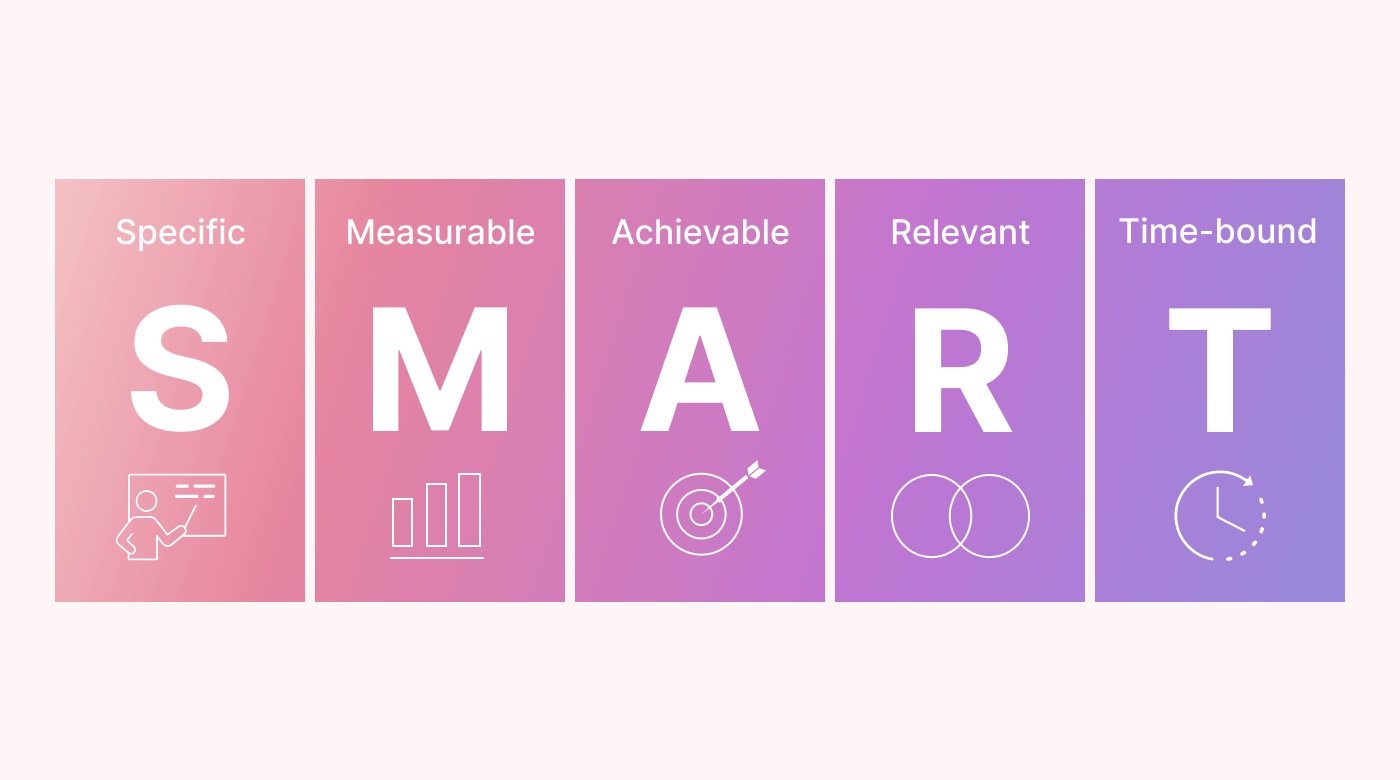It's easy to get swept up in a new and exciting idea — but hold fire. Before you run with it, you need to prove that this business idea is investing time, money, and resources to bring it to life.
The last thing you want to do is get ahead of yourself and start creating something new, only to realize it’s not working out.
This is where a proof of concept can help.
In this guide, we’ll explain what a proof of concept is, how it’s different from a prototype or a minimum viable product (MVP), and we’ll walk you through eight steps you can follow to prepare your own proof of concept.
What is a proof of concept?
A proof of concept (POC) refers to a small-scale demonstration or trial that reviews the feasibility and viability of a particular idea. It’s like doing a small test or experiment to see if an idea could work before you invest time and money in creating it.
Think about clinical trials as an example. Pharmaceutical companies run trials to test the effects and viability of new drugs and medicines. These tests show how the drugs will work, how effective they are, and whether they’re worth development.
The proof of concept process also helps you identify risks and challenges with your idea, enabling you to avoid potential hurdles.
If we use the clinical trials example again, you can use the results of these tests to identify potential side effects with the medicine. Then, you can identify how to overcome these side effects before you start producing the medicine.
By proactively addressing challenges before they happen, you can also address any concerns that high-level management might have. If you need their approval to move the product idea forward, this is a great way to get their buy-in and show them how the concept is worth continuing.
On top of this, POC provides a basis for informed decision-making. With the results from your test, you can make informed, smart decisions before investing significant resources. As a result, you minimize waste and allocate resources effectively.
Proof of concept vs prototype: What’s the difference?
Both POC and prototypes play important roles in developing and validating new ideas, but they serve different purposes and have different scopes.
While a POC focuses on validating the feasibility of a concept, a prototype is an actual working model of the concept. It’s often used for gathering feedback from stakeholders and end-users to make improvements before the final development.
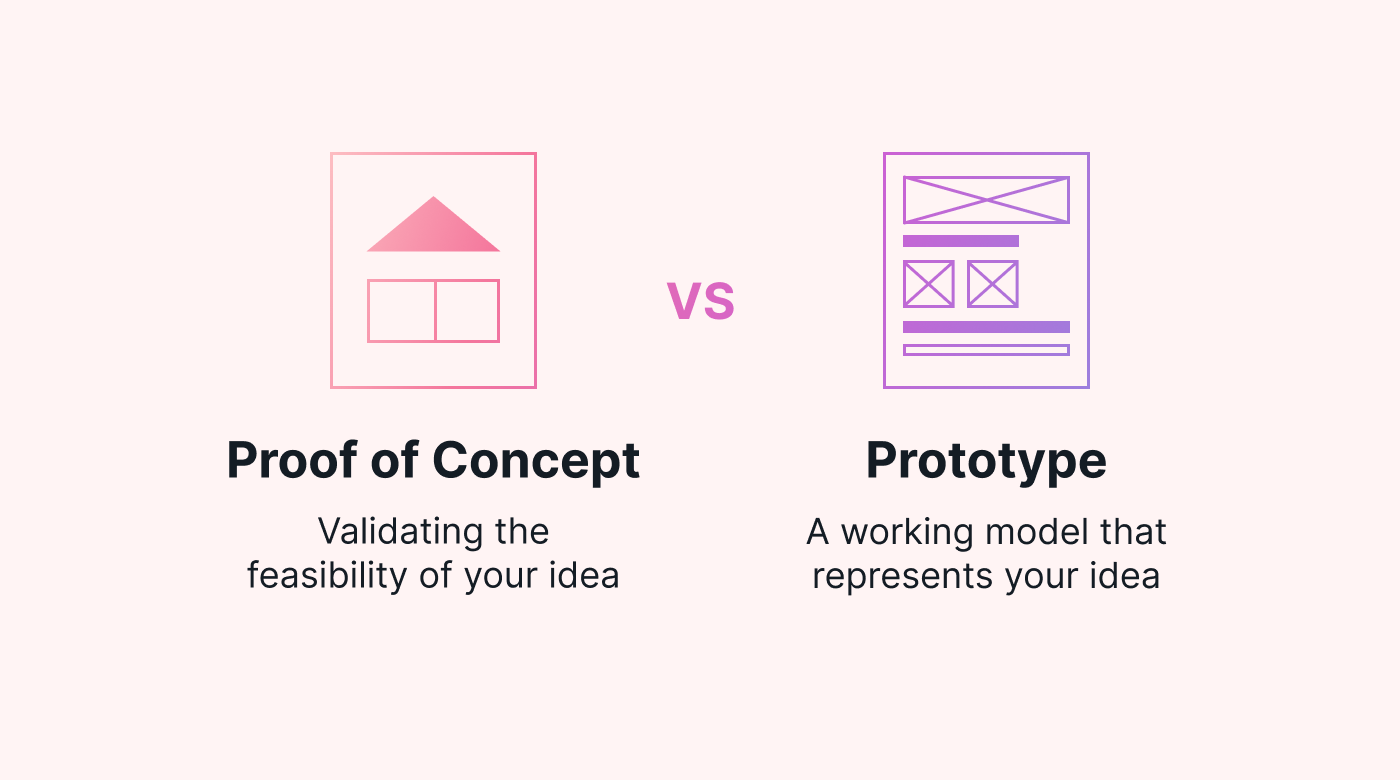 |
Let’s use an example to demonstrate the differences.
Imagine you want to create a website. Before investing heavily in web development, you develop a proof of concept. In this POC, you outline the main idea for the website, how it’ll work, and the benefits of creating it.
After successfully validating the concept through the POC, you start creating a prototype — a wireframe of the website. This allows you to create a more detailed and functional version of the website to see how it works and gather feedback from colleagues and end-users.
Proof of concept vs. minimum viable product (MVP): What’s the difference?
An MVP is a functioning product. It provides the most basic product version that can be released to the market, with enough features to satisfy early customers and gather user feedback. It focuses on delivering value to potential users, testing assumptions, and validating the product-market fit.
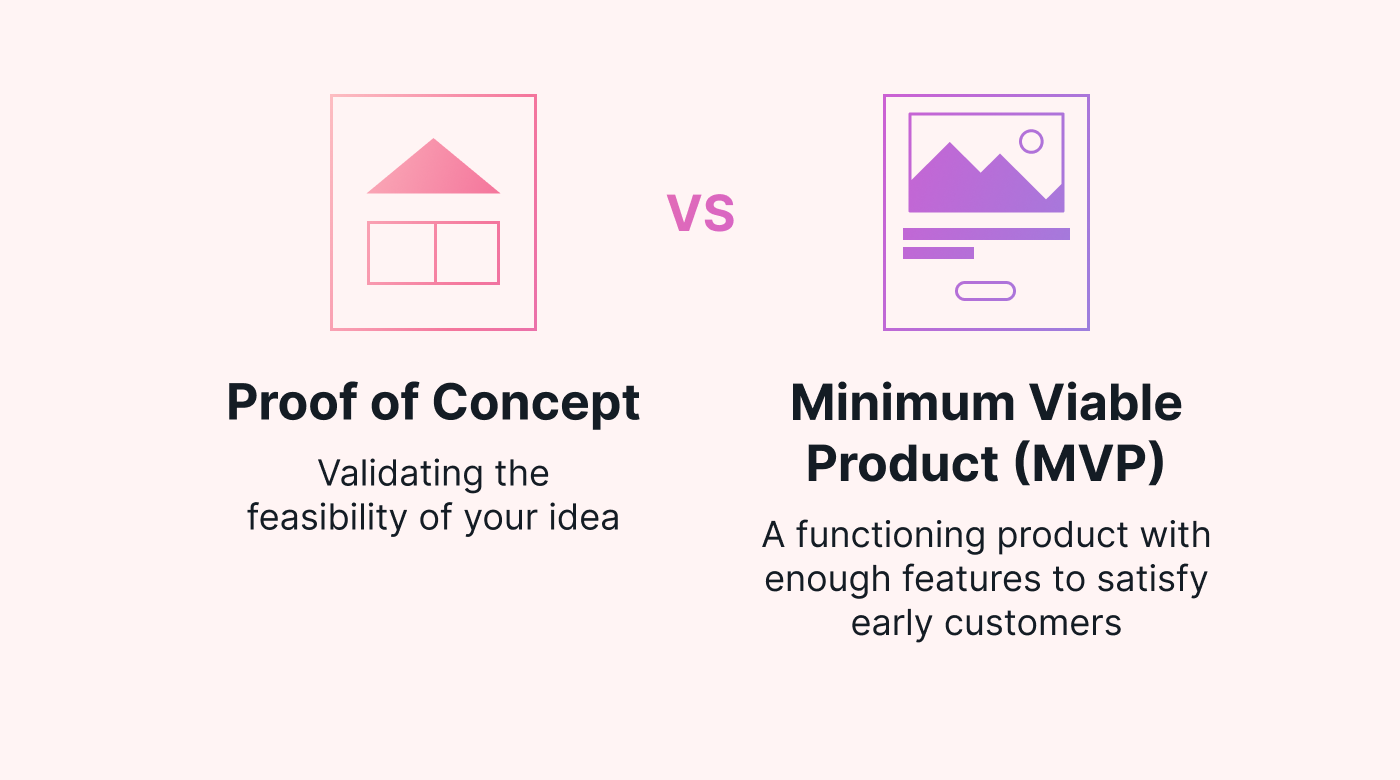 |
The MVP stage takes place further along the development process than the POC. The POC answers, ‘Can we do it?’ while the MVP focuses on answering, ‘Should we do it, and how can we improve it?’
What is a proof of concept example?
Let’s use the development of a mobile app for a transportation company as an example.
Suppose a transportation company wants to explore the feasibility of developing a mobile app. The app would allow customers to book and track rides in real-time, making using the service easier.
The company conducts a POC to validate the concept and assess its potential.
The POC involves conducting user and market research. Then, the team creates a simplified version of the mobile app. The app has limited functionality, including the following features:
- User registration
- Ride booking
- Real-time tracking
- Basic payment integration
The transportation company selects some internal employees to test the app and gather feedback. This feedback helps evaluate the concept's feasibility and identify any potential issues or improvements.
The transportation company can make informed decisions about further investment in the app’s development based on feedback and insights gathered from the POC.
Remember: POC is a pre-prototype project. It’s used to decide whether it's possible to implement particular functionalities and have a working product at the same time. In this situation, the app isn't ready for user testing. It’s a simple case of testing functionality to see if it’s possible before making an official prototype.
How to create a proof of concept
Now that we know what a proof of concept is, let’s walk through the steps you can follow to create a POC of your own.
1. Define the objective
Start by clearly defining the objective of the POC. This means confirming what you want to validate with the concept and creating specific goals to measure and evaluate its success.
So let’s say you want to create a POC for a new product. First, you’ll confirm what you want to validate:
The concept is to create a smart home automation system that allows homeowners to control various home devices and appliances using a mobile app.
Then, you’ll create goals to keep yourself on track and measure your success.
To do this, think about using SMART goals.
SMART is a goal-setting framework that helps you set specific, measurable, achievable, relevant, and time-bound goals.
In this situation, your SMART goal could be as follows:
By the end of the next four weeks, we'll complete a POC for the smart home automation system in a single room, seeing if the mobile app can control the smart thermostat, smart lights, and smart outlets without any major issues.
2. Identify key assumptions
Assumptions are the key aspects that need validation through your POC. For example, if you’re creating a work management app, one of your assumptions might be as follows:
Busy professionals will find value in using the app to track and manage their daily tasks and schedules effectively.
By outlining this assumption, you can focus on proving whether it’s true or false throughout the POC process. It helps you (and other decision-makers) to make an informed decision about whether to proceed with the project.
Here’s how to pinpoint the key assumptions for your POC:
- List all your assumptions. Based on your research and experience, list all your predictions about the POC. This will encourage you to get the ball rolling and use your own assumptions as a foundation to build on.
- Consider stakeholder perspectives. Think about the different stakeholders involved in the POC, including end-users, project sponsors (such as high-level management), and team members. Consider their perspectives and assumptions they might have about the concept.
- Identify key features. Determine which elements of the concept you need to test to ensure its viability. From here, you can outline your assumptions about these elements. By doing this, you make sure that you cover all the key features of the product or solution.
3. Scope and simplify
The next step is to outline the scope of your POC, which involves simplifying the concept to its essential components and outlining the boundaries of work. The aim is to strip away unnecessary complexities and focus solely on the core features or functionalities of the POC.
Here’s how to outline the scope of your POC:
- Identify your core features. The first step is to pinpoint your core features and components. This will help you narrow down what to focus on in your POC and ensure you cover the most important features.
- Set boundaries. Next, you should consider what your boundaries should be for the POC. This means confirming what work to include in your POC and what won’t be covered. For example, if you’re launching a new website, you might cover navigation and user design, but you won’t cover technical aspects.
- Limit the scope of data. If your POC involves data analysis or processing, limit the amount of data you work with. Focus on a small, representative dataset rather than trying to handle large volumes of data so you can really focus on the data that matters most.
4. Build a scaled-down version of your idea
With a clear vision for your POC, you can now build and develop a scaled-down version of your concept. The aim is to demonstrate the key functionalities or benefits before moving on to a prototype.
You can use a variety of tools, technologies, or platforms to quickly create a representative model of your concept. Even if you’re planning to create a physical product, you can use technology to map the design and create a virtual representation of it.
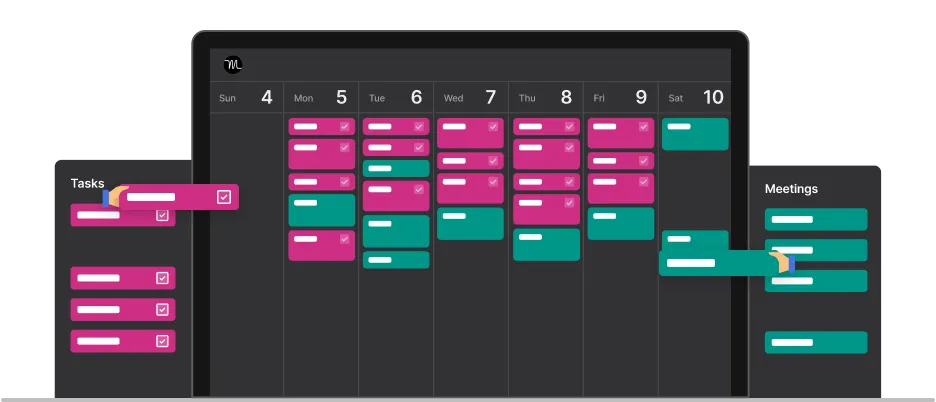 |
The design doesn't need to be perfect. However, it should be functional enough to internally test the critical aspects. For instance, if you’re creating an online store, you need to have a testable version to see if it’s worth moving the project along.
This means designing an online store that has basic user functions. It doesn’t have to look pretty, but you must see if it works. Then, you can share the site with colleagues for testing — which is the next step.
5. Test and validate
When the model is complete, you can run a test in a controlled environment. Exactly how you do this depends on the type of product or solution you’re testing. So long as it’s in a controlled environment with a limited user group, you can run it however you’d like.
As part of the testing process, you’ll collect feedback and gather data on the performance, usability, and effectiveness of your POC. Then, you’ll compare the results with the success criteria from your SMART goal.
Let’s use our initial SMART goal as an example.
In our example, we defined success as creating a POC for a smart home automation system. The system should be able to control the smart thermostat, smart lights, and smart outlets without any big issues.
So, when analyzing the feedback and reviewing the functionality, you’ll compare the results with this SMART goal. If the results indicate that you’ve met the success criteria, you’re heading in the right direction.
If not, the project might be a no-go, or you may need to amend your POC. The good news is that you can learn from the results of the tests to refine and enhance your idea. Use this knowledge to keep improving your POC until you achieve what you want.
6. Create your proof of concept
The last step is to create your POC. To do this, you’ll document the findings, lessons learned, and outcomes of your research and testing. You’ll also capture the strengths, weaknesses, opportunities, and potential risks you discovered during the validation process.
Then, you can prepare a presentation or report summarizing the findings from your POC. This means you’ll share the outcomes with stakeholders, decision-makers, or potential investors to gather their input and approval to move forward.
The POC documentation also serves as a reference for future decision-making. For example, you may need to refer to it when creating your prototype or your MVP to make sure you’re heading in the right direction.
And here’s a tip, if you save everything on an online platform like Motion, everyone on the project team can easily access vital POC information.
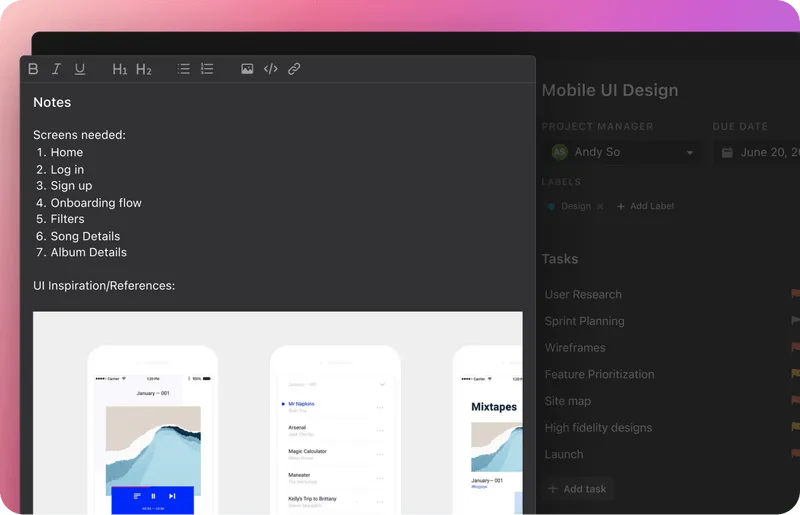 |
This keeps everyone on the same page and ensures they all work towards the same goal.
Use Motion to prepare your proof of concept
Proof of concept is an important process in the software, product and even service development process. It helps you validate new ideas and make sure that you’re investing your time and money in the right projects.
To collaborate with your project team during this process, consider using an online work management tool like Motion. With our software, you can easily share information with colleagues and track the POC process in a central location. Sign up for a free trial to see it for yourself.


